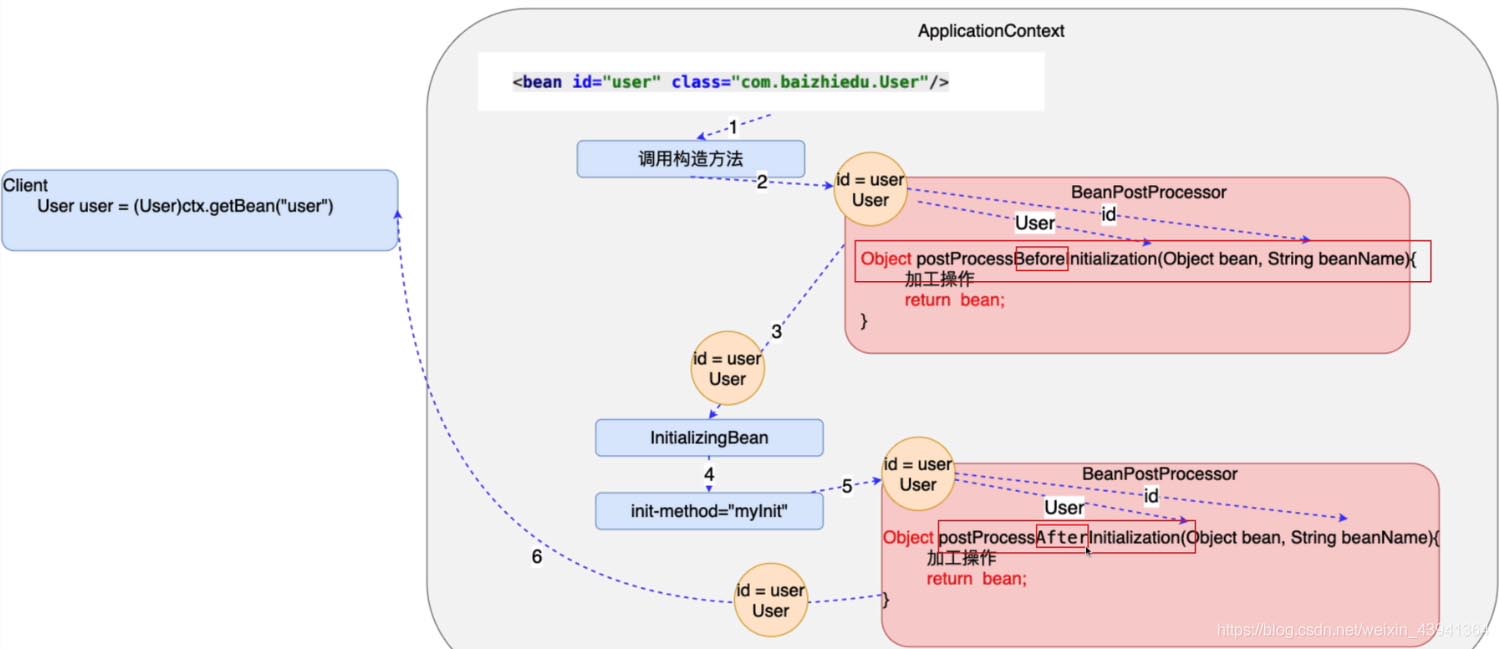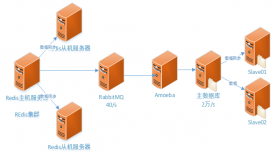Spring BeanPostProcessor执行顺序

首先 Spring 通过调用构造方法创建 User 对象;
User 对象创建好之后,先不直接进行初始化操作,通过 BeanPostProcessor 对刚创建好的 User 对象进行加工操作,其中 postProcessBeforeInitialization 方法的第一个参数是 User 对象,第二个参数是在配置文件中指定的 id 值;
加工好之后通过 return 将对象返回给 Spring 容器,然后 Spring 容器继续按照流程执行 初始化操作,先是 InitializingBean 的初始化操作;
再是 init-method 的初始化;
然后 Spring 容器再次将对象交给 BeanPostProcessor ,执行 postProcessAfterInitialization 方法。
实际上在实战中,我们很少处理 Spring 的初始化操作,所以没有必要区分 Before 还是 After。只需要实现其中的一个即可,显然选 After 方法更好。
先定义一个实体类 Category:
|
1
2
3
4
5
6
7
8
9
10
11
12
13
14
15
16
17
18
19
20
21
22
23
|
public class Category { private Integer id; private String name; public Integer getId() { return id; } public void setId(Integer id) { this.id = id; } public String getName() { return name; } public void setName(String name) { this.name = name; } @Override public String toString() { return "Category{" + "id=" + id + ", name='" + name + '\'' + '}'; }} |
然后注入到 Spring 容器中:
|
1
2
3
4
|
<bean class="edu.lsu.pojo.Category" id="category"> <property name="id" value="1"/> <property name="name" value="迪丽热巴"/></bean> |
注意此时的名字是迪丽热巴。
此时我们定义一个 BeanPostProcessor,实现他的后置处理器方法:
|
1
2
3
4
5
6
7
8
9
10
11
12
|
public class MyBeanPostProcessor implements BeanPostProcessor { @Override public Object postProcessBeforeInitialization(Object bean, String beanName) throws BeansException { return bean; } @Override public Object postProcessAfterInitialization(Object bean, String beanName) throws BeansException { Category category = (Category) bean; category.setName("古力娜扎"); return category; }} |
当我们在此时的时候,输出结果就是古力娜扎;
|
1
2
3
4
5
6
|
@Testpublic void test7() { ApplicationContext ac = new ClassPathXmlApplicationContext("/applicationContext2.xml"); Category category = ac.getBean("category", Category.class); System.out.println("category = " + category);} |
输出:
category = Category{id=1, name='古力娜扎'}
Spring-BeanPostProcessor接口总结
定义
Spring提供了一个BeanPostProcessor接口,这个接口的作用在于对于新构造的实例可以做一些自定义的修改。比如如何构造、属性值的修改、构造器的选择。
如果想改变Spring容器中bean的一些属性或者行为,可以通过自定义类实现BeanPostProcessor接口实现。
以下基本Spring-beans 5.0.6版本说明。
BeanPostProcessor
|
1
2
3
4
5
6
7
8
|
@Nullabledefault Object postProcessBeforeInitialization(Object bean, String beanName) throws BeansException { return bean;}@Nullabledefault Object postProcessAfterInitialization(Object bean, String beanName) throws BeansException { return bean;} |
BeanPostProcessor总结
- postProcessBeforeInitialization方法的作用在于目标对象实例化之后,初始化之前调用,默认返回原始对象,也可以返回一个包装实例;
- 如果返回null,接下来的BeanPostProcessors都不会执行
- postProcessAfterInitialization方法的作用在于目标对象实例化之后,初始化之后调用,默认返回原始对象,也可以返回一个包装实例;
- 如果返回null,接下来的BeanPostProcessors都不会执行
- 初始化(Initialization):表示生成对象,未设置属性;初始化之前表示bean的初始化回调之前,如InitializingBean接口的afterPropertiesSet方法或者自定义的init-method方法
InstantiationAwareBeanPostProcessor
InstantiationAwareBeanPostProcessor接口继承自BeanPostProcessor接口,定义了3个方法
|
1
2
3
4
5
6
7
8
9
10
11
12
|
@Nullabledefault Object postProcessBeforeInstantiation(Class<?> beanClass, String beanName) throws BeansException { return null;}default boolean postProcessAfterInstantiation(Object bean, String beanName) throws BeansException { return true;}@Nullabledefault PropertyValues postProcessPropertyValues( PropertyValues pvs, PropertyDescriptor[] pds, Object bean, String beanName) throws BeansException { return pvs;} |
InstantiationAwareBeanPostProcessor总结
- postProcessBeforeInstantiation方法在目标对象实例化之前调用,可以返回一个代理对象来代替目标对象本身;如果返回非null对象,则除了调用postProcessAfterInitialization方法外,其他bean的构造过程都不再调用;
- postProcessAfterInstantiation方法在对象实例化之后,属性设置之前调用;如果返回值是true,目标bean的属性会被populate,返回false则忽略populate过程;
- postProcessPropertyValues方法在属性被设置到目标实例之前调用,可以修改属性的设置,PropertyValues pvs表示参数值,PropertyDescriptor[] pds表示目标bean 的属性描述信息,返回值PropertyValues,可以用一个全新的PropertyValues来替代原来的pvs,如果返回null,将忽略属性设置过程;
SmartInstantiationAwareBeanPostProcessor
SmartInstantiationAwareBeanPostProcessor接口继承InstantiationAwareBeanPostProcessor接口,定义了3个方法,作用是在于目标对象的实例化过程中需要处理的事情。
|
1
2
3
4
5
6
7
8
9
10
11
12
|
@Nullabledefault Class<?> predictBeanType(Class<?> beanClass, String beanName) throws BeansException { return null;}@Nullabledefault Constructor<?>[] determineCandidateConstructors(Class<?> beanClass, String beanName) throws BeansException { return null;}default Object getEarlyBeanReference(Object bean, String beanName) throws BeansException { return bean;} |
SmartInstantiationAwareBeanPostProcessor总结
- predictBeanType方法预测Bean的类型,返回预测成功的Class类型,默认或如果不能预测返回null
- determineCandidateConstructors方法用于选择合适的构造器,如果类有多个构造器,可以实现这个方法选择合适的构造器并用于实例化对象;该方法在postProcessBeforeInstantiation方法和postProcessAfterInstantiation方法之间调用,如果postProcessBeforeInstantiation方法返回了一个新的实例代替了原本该生成的实例,那么该方法会被忽略;
- getEarlyBeanReference方法用于解决循环引用问题。比如ReferenceA实例内部有ReferenceB的引用,ReferenceB实例内部有ReferenceA的引用。首先先实例化ReferenceA,实例化完成之后提前把这个bean暴露在ObjectFactory中,然后populate属性,这个时候发现需要ReferenceB。然后去实例化ReferenceB,在实例化ReferenceB的时候它需要ReferenceA的实例才能继续,这个时候就会去ObjectFactory中找出了ReferenceA实例,ReferenceB顺利实例化。ReferenceB实例化之后,ReferenceA的populate属性过程也成功完成,注入了ReferenceB实例。提前把这个bean暴露在ObjectFactory中,这个ObjectFactory获取的实例就是通过getEarlyBeanReference方法得到的;
DestructionAwareBeanPostProcessor
|
1
2
3
4
|
void postProcessBeforeDestruction(Object bean, String beanName) throws BeansException;default boolean requiresDestruction(Object bean) { return true;} |
DestructionAwareBeanPostProcessor总结
postProcessBeforeDestruction方法在目标bean被销毁之前调用,该回调适用于单例bean的使用;
判断目标bean是否需要回调postProcessBeforeDestruction方法;
总结一下
Spring内部对象bean的生命周期管理有一套完成的体系,并遵循了设计模式中的开闭原则(开放扩展,关闭修改),如果想修改bean的相关信息,可以通过Spring提供的扩展点,如BeanPostProcessor接口去处理,这样做的好处是不需要关心Spring内部处理逻辑,扩展方便。
以上为个人经验,希望能给大家一个参考,也希望大家多多支持服务器之家。
原文链接:https://wangsuo.blog.csdn.net/article/details/108466628















